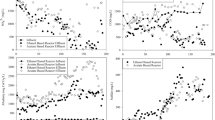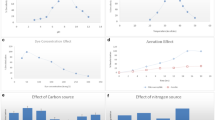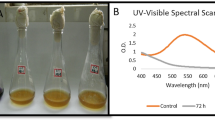Abstract
Anaerobic biodegradability of wastewater (3,000 mg CODcr/l) containing 300 mg/l Reactive Blue 4, with different co-substrates, glucose, butyrate and propionate by a bacterial consortium of Salmonella subterranea and Paenibacillus polymyxa, concomitantly with hydrogen production was investigated at 35°C. The accumulative hydrogen production at 3,067 mg CODcr/l was obtained after 7 days of incubation with glucose, sludge, the bacterial consortium. The volatile fatty acids, residual glucose and the total organic carbon were correlated to hydrogen obtained. Interestingly, the bacterial consortium possess decolorization ability showing approximately 24% dye removal after 24 h incubation using glucose as a co-substrate, which was about two and eight times those of butyrate (10%), propionate (12%) and control (3%), respectively. RB4 decolorization occurred through acidogenesis, as high volatile fatty acids but low methane was detected. The bacterial consortium will be the bacterial strains of interest for further decolorization and hydrogen production of industrial waste water.




Similar content being viewed by others
References
Aksu Z, Tezer S (2005) Biosorption of reactive dyes on the green alga Chlorella vulgari. Process Biochem 40:1347–1361. doi:10.1016/j.procbio.2004.06.007
Bothe H, Winkelmann S, Boison G (2008) Maximizing hydrogen production by cyanobacteria. Z Naturforsch 63(C):226–232
Chen CC, Lin CY, Lin MC (2002) Acid-base enrichment enhances anaerobic hydrogen production process. Appl Microbiol Biotechnol 58(2):224–228. doi:10.1007/s002530100814
Dos Santos AB, Bisschops IAE, Cervantes FJ, Van Lier JB (2005) The transformation and toxicity of anthraquinone dyes during thermophilic (55°C) and mesophilic (30°C) anaerobic treatments. J Biotechnol 15:345–353. doi:10.1016/j.jbiotec.2004.09.007
Elam CC, Gregoire Padro CE, Sandrock G, Luzzi A, Lindblad P, Hagen EF (2003) Realizing the hydrogen future: the International Energy Agency’s efforts to advance hydrogen energy technologies. Int J Hydrogen Energy 28:601–607. doi:10.1016/S0360-3199(02)00147-7
Fang HHP, Liu H (2002) Effect of pH on hydrogen production from glucose by a mixed culture. Bioresour Technol 82(2):87–93. doi:10.1016/S0960-8524(01)00110-9
Fang HHP, Liu H, Zhang T (2004) Bio-hydrogen production from wastewater. Water Sci Technol Water Supply 4(1):77–85
Fu Y, Viraraghavan T (2001) Fungal decolorization of dyewastewaters: a review. Bioresour Technol 79:251–262. doi:10.1016/S0960-8524(01)00028-1
Hart D (1997) Hydrogen power: the commercial future of “the ultimate fuel”. Financial Times Energy Publishing, London
Hawkes FR, Dinsdale R, Hawkes DL, Hussy I (2002) Sustainable fermentative hydrogen production: challenges for process optimisation. Int J Hydrogen Energy 27(11–12):1339–1347. doi:10.1016/S0360-3199(02)00090-3
Jun YS, Yu SH, Ryu KG, Lee TJ (2008) Kinetic study of pH effects on biological hydrogen production by a mixed culture. J Microbiol Biotechnol 18(6):1130–1135
Kapdan IK, Kargi F (2006) Bio-hydrogen production from waste materials. Enzyme Microb Technol 38(5):569–582. doi:10.1016/j.enzmictec.2005.09.015
Khanal SK, Chen WH, Li L, Sung S (2004) Biological hydrogen production: effects of pH and intermediate products. Int J Hydrogen Energy 29(11):1123–1131
Kumar N, Das D (2000) Enhancement of hydrogen production by Enterobacter cloacae IIT-BT 08. Process Biochem 35(6):589–593. doi:10.1016/S0032-9592(99)00109-0
Laszlo JA (1995) Electrolyte effects on hydrolyzed reactive dye binding to quaternized cellulose. Textile Chemist Colorist 27(4):25–27
Lay JJ (2000) Modeling and optimization of anaerobic digested sludge converting starch to hydrogen. Biotechnol Bioeng 68(3):269–278. doi:10.1002/(SICI)1097-0290(20000505)68:3<269::AID-BIT5>3.0.CO;2-T
Lee KK, Kassim AM, Lee HK (2004) The effect of nitrogen supplementation on the efficiency of color and COD removal by Malaysian white-rot fungi in textile dyeing effluents. Water Sci Technol 50:73–78
Lee YH, Matthews RD, Pavlostathis SG (2005) Biological decolorization of reactive anthraquinone and phthalocyanine dyes under various oxidation-reduction conditions. Water Sci Technol 52(1–2):377–383
Liu D, Zeng RJ, Angelidaki I (2008) Effects of pH and hydraulic retention time on hydrogen production versus methanogenesis during anaerobic fermentation of organic household solid waste under extreme-thermophilic temperature (70°C). Biotechnol Bioeng 100(6):1108–1114. doi:10.1002/bit.21834
Manu B, Chaudhari S (2002) Anaerobic decolorization of simulated textile wastewater containing azo dyes. Bioresour Technol 82:225–231. doi:10.1016/S0960-8524(01)00190-0
McCarty PL, Smith DP (1986) Anaerobic wastewater treatment. Environ Sci Technol 20:1200–1206. doi:10.1021/es00154a002
Melis A, Happe T (2001) Hydrogen production. Green algae as a source of energy. Plant Physiol 127(3):740–748. doi:10.1104/pp.127.3.740
Melpei F, Andreoni V, Daffonchio D, Rozzi A (1998) Anaerobic digestion of print pastes: a preliminary screening of inhibition by dyes and biodegradability of thickeners. Bioresour Technol 63:49–56. doi:10.1016/S0960-8524(97)00109-0
Mu Y, Zheng WJ, Yu HQ, Zhu RF (2006) Biological hydrogen production by anaerobic sludge at various temperature. Int J Hydrogen Energy 31:780–785. doi:10.1016/j.ijhydene.2005.06.016
Nandi R, Sengupta S (1998) Microbial production of hydrogen: an overview. Crit Rev Microbiol 24(1):61–84. doi:10.1080/10408419891294181
Omar HH (2008) Algal decolorization and degradation of monoazo and diazo dyes. Pak J Biol Sci 11(10):1310–1316
Pitwell LR (1983) Standard COD. Chem Br 19:907
Revenga J, Rodriguez F, Tijero J (1994) Study of redox behavior of anthraquinone in aqueous medium. J Electrochem Soc 141(2):330–333. doi:10.1149/1.2054725
Rys P, Zollinger H (1989) Reactive dye-fiber systems. The theory of coloration of Textiles. In: Johnson A (ed) Society of dyers and colorists, West Yorkshire, England, pp 552
Singh S, Chandra R, Patel DK, Reddy MM, Rai V (2008) Investigation of the biotransformation of pentachlorophenol and pulp paper mill effluent decolorisation by the bacterial strains in a mixed culture. Bioresour Technol 99(13):5703–5709. doi:10.1016/j.biortech.2007.10.022
Taguchi F, Chang JD, Mizukami N, Saito-Taki T, Hasegawa K, Morimoto M (1993) Isolation of a hydrogen-producing bacterium, Clostridium beijerinckii strain AM21B. Can J Microbiol 39(7):726–730
Takabatake H, Suzuki K, Ko IB, Noike T (2004) Characteristics of anaerobic ammonia removal by a mixed culture of hydrogen producing photosynthetic bacteria. Bioresour Technol 95:151–158. doi:10.1016/j.biortech.2003.12.019
Tao Y, Chen Y, Wu Y, He Y, Zhou Z (2007) High hydrogen yield from a two-step process of dark- and photo-fermentation of sucrose. Int J Hydrogen Energy 32:200–206. doi:10.1016/j.ijhydene.2006.06.034
Vandevivere PC, Bianchi R, Verstraete W (1998) Treatment and reuse of wastewater from the textile wet-processing industry: review of emerging technologies. J Chem Technol Biotechnol 72:289–320. doi:10.1002/(SICI)1097-4660(199808)72:4<289::AID-JCTB905>3.0.CO;2-#
Wang X, Hoefel D, Saint CP, Monis PT, Jin B (2007) The isolation and microbial community analysis of hydrogen producing baceria from activated sludge. J Appl Microbiol 103:1415–1423. doi:10.1111/j.1365-2672.2007.03370.x
Zheng XJ, Yu HQ (2005) Inhibitory effects of butyrate on biological hydrogen production with mixed anaerobic cultures. J Environ Manage 74:65–70
Zollinger H (1991) Color chemistry, 2nd edn. VHC publishers, New York
Acknowledgments
This research was supported by JSPS-NRCT (Microbial Resources Program) and Thailand Research Fund.
Author information
Authors and Affiliations
Corresponding author
Rights and permissions
About this article
Cite this article
Watanapokasin, R.Y., Boonyakamol, A., Sukseree, S. et al. Hydrogen production and anaerobic decolorization of wastewater containing Reactive Blue 4 by a bacterial consortium of Salmonella subterranea and Paenibacillus polymyxa . Biodegradation 20, 411–418 (2009). https://doi.org/10.1007/s10532-008-9232-0
Received:
Accepted:
Published:
Issue Date:
DOI: https://doi.org/10.1007/s10532-008-9232-0




